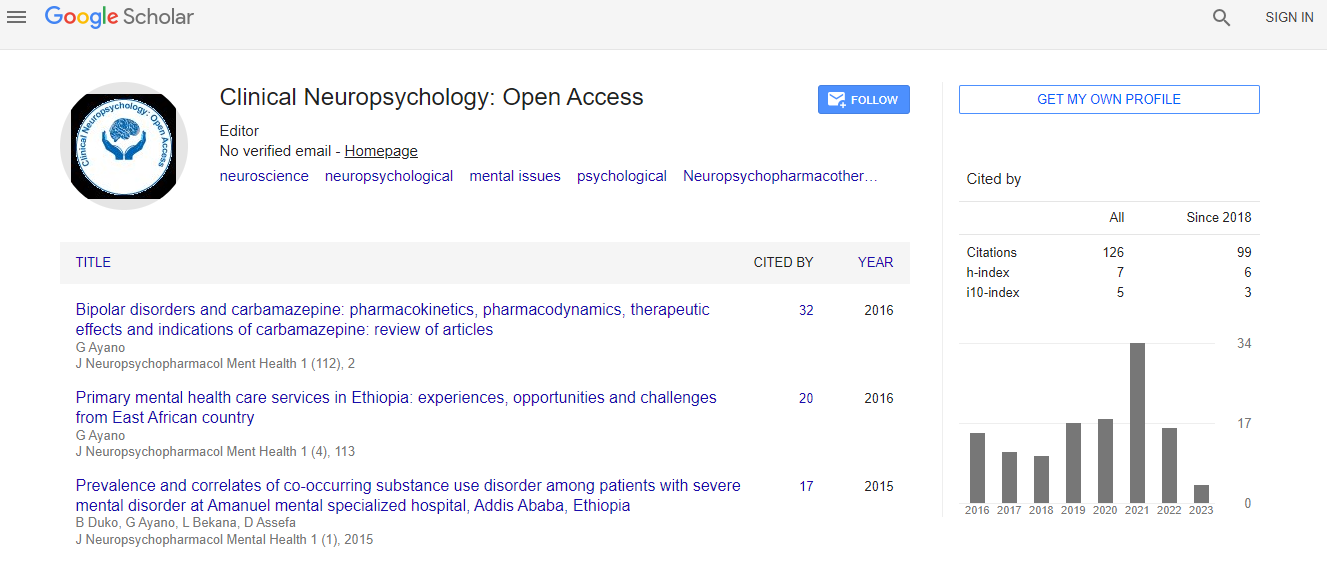Our Group organises 3000+ Global Conferenceseries Events every year across USA, Europe & Asia with support from 1000 more scientific Societies and Publishes 700+ Open Access Journals which contains over 50000 eminent personalities, reputed scientists as editorial board members.
Open Access Journals gaining more Readers and Citations
700 Journals and 15,000,000 Readers Each Journal is getting 25,000+ Readers
Google Scholar citation report
Citations : 141
Clinical Neuropsychology: Open Access received 141 citations as per Google Scholar report
Indexed In
- Google Scholar
- RefSeek
- Hamdard University
- EBSCO A-Z
- OCLC- WorldCat
Useful Links
Recommended Journals
Related Subjects
Share This Page
Building health research capacity in Africa for UHC: The profile of stroke in Jos, north-central Nigeria
8th Global Experts Meeting on Advances in Neurology and Neuropsychiatry
Osaigbovo Osawaru Godwin, Amusa G A, Salaam A, Imoh C L and Sagay A SMalgorzata M Bala
Jos University Teaching Hospital, Nigeria
Posters & Accepted Abstracts: ClinNeuropsychol
Abstract
Background: Stroke is the second leading cause of death worldwide. Stroke mortality has been shown to be higher in blacks in multiracial studies; it is also a very important cause of disability with its attendant deterioration in the quality of life in survivors. The profile of stroke in north-central Nigeria has been sparsely described despite the fact that it constitutes about 50 to 60% of neurological admission in this part of the world. Objectives: To determine the risk factors associated with stroke, assess the case fatality 90 days post stroke, determine the bad prognostic factors of stroke and assess the sensitivity and specificity of clinical sub-typing of stroke using the WHO and Siriraj stroke scoring tools. Method: A longitudinal cohort study with a 90 day follow up for secondary outcome was carried out on stroke patients admitted into the Neurology Unit of Jos University Teaching Hospital over a 2-year period, September 2016 to August, 2018. Results: A total of 246 stroke patients were admitted during the study period. Males were 131 (53.3%) and females 115 (46.6%) with an age range of 59.5±13.1 for males and 56.7±14.2 for females. Hypertension (81.7%), obesity (80.9%), dyslipidemia (54.5%), alcohol consumption (24.8%), carotid plaques (19.5%), cardiac disease (19.1%) and diabetes mellitus (18.5%) were the commonest risk factors for stroke. The 90 days fatality for stroke was 22%; however, 37% became disabled and unable to carry out activities of daily living without support. Significant predictors of mortality and morbidity were coma, elevated glycated hemoglobin, cardiac disease, HIV infection and high National Institute of Health Stroke Score (NIHSS). WHO clinical stroke sub typing showed a sensitivity of 54.3% and a specificity of 86.3% while Siriraj has a sensitivity of 87.9% and specificity of 84.9% for ischemic stroke, however, for hemorrhagic stroke, WHO sub typing revealed a sensitivity of 86.3% and a specificity of 54.3% while Siriraj was found to have a sensitivity of 84.9% and specificity of 87.9%, showing that Siriraj is a better tool for stroke categorization for appropriate management in areas where neuroimaging are either not readily available or not affordable. Conclusion: Stroke is a major cause of mortality and morbidity in north central Nigeria. Community screening for risk factors should be pursued aggressively and identified risk factors managed promptly in order to reduce the burden of this pandemic. Siriraj stroke sub typing can be used in resource limited setting like ours where neuroimaging facilities are either not available or are too expensive.Biography
Osaigbovo Osawaru Godwin is presently working at Jos University Teaching Hospital, Nigeria.
E-mail: osaigodwin20@gmail.com

 Spanish
Spanish  Chinese
Chinese  Russian
Russian  German
German  French
French  Japanese
Japanese  Portuguese
Portuguese  Hindi
Hindi 